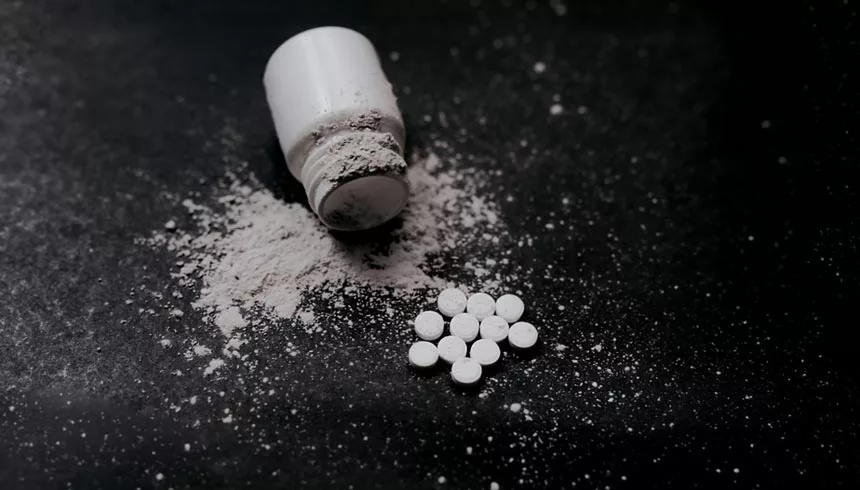Beyond Fentanyl: The Rise of Frankenstein Opioids
Table of Contents
- Beyond Fentanyl: The Rise of Frankenstein Opioids
- What Is Nitazene and How Does It Work?
- The Risk of Ingesting Nitazene
- A Growing Concern: Even More Lethal Opioids
- A New Set of Challenges for Harm Reduction
- The Dangers of Analog Psychoactive Substances
- Tips Regarding Synthetic Drugs and Novel Psychoactive Substances
- Get Help for Synthetic Opioid Abuse Now
- FAQS About Nitazene and Frankenstein Opioids
- Medically Reviewed By
Since the mass distribution and spread of heroin in the United States – or any drug for that matter – users have always remained vigilant regarding what their drug of choice might be adulterated with. A minor issue decades ago, this growing problem has stretched to epic proportions, becoming almost epidemic within an epidemic.
In fact, the current fentanyl epidemic began as an adulteration issue for the heroin supply. Growing numbers of large heroin batches began testing positive for fentanyl in the mid-2000s, which eventually gave way to our current situation – an almost complete takeover of the natural heroin supply by its synthetic counterpart, along with record numbers of deaths by overdose.
Currently, substances known as Nitazene drugs – from the family of synthetic opioids, have made their way into the American heroin and fentanyl supply. However, this is no research chemical or designer drug – in fact, it’s been around for decades but never considered on the recreational drug market.
If you or someone you love is abusing a natural opioid or synthetic opioid, you owe it to them or yourself to be aware of this deadly drug causing overdose deaths to swell even further.
Keep reading, and please reach out for proven treatment options nationwide if opioid use has become a part of your life or that of a loved one. The risks grow greater each day, so stay informed!
What Is Nitazene and How Does It Work?
As we speak, newer, and deadlier, research chemicals are now making their way into the fentanyl supply. A half-decade ago, whispers of Carfentanil, a substance that falls under the class of synthetic opioids, began surfacing in the drug supply. This was alarming, considering the potency of this synthetic opioid was far greater than fentanyl.
Nitazene, a powerful lab-made drug, joins fentanyl in the category of synthetic opioids and now sits beside the drug as one of the leading causes of overdose deaths. It acts in a similar fashion as other synthetic opioids, as it increases the amount of dopamine released by the brain. This leads to the same high that keeps users coming back again and again – only far more potent.
The Origins of Nitazene
So what makes Nitazene so dangerous? And where did this not-so-new drug come from?
Nitazenes are actually a group of synthetic compounds created in 1957 with the goal of administration as an analgesic. However, because of its extreme potency (1,000s of times more powerful than morphine), and the risk of causing dependence and other dangerous effects, it was never branded or sold commercially.
Because of the intensity and strength of nitazenes, they were often likened to fentanyl. However, because they are completely different structurally than fentanyl and other drugs like morphine and the fentanyl analog meperidine, the medical and science world maintained an interest in them for the purpose of researching opioid mechanisms.
Over the last few years, analog versions of nitazenes have begun emerging in the European and American drug markets, often as an adulterant in large batches of heroin and fentanyl. The most common of these analogs is known as isotonitazene, otherwise known as ISO or TONY.
First Appearance in America
Nitazenes are formulated into fake pills, distributed as powders, and even liquids – and most often combined with fentanyl and benzos. The most dangerous element of this drug is the fact that 99% of the time, the user has no idea these drugs are mixed in with what they’re ingesting.
There is no known drug test for nitazenes, making them nearly possible to detect in urinalysis or even drug test kits sold for the purpose of user safety. The first mass emergency involving nitazene took place in Knoxville, TN, in 2021.
Out of 218 overdose deaths, 26 of those victims had metonitazene in their systems – another analog. In every case, the drug was combined with fentanyl.
The Risk of Ingesting Nitazene
Several dangers exist for those who unknowingly ingest nitazene or any of its analogs. The most commonly associated dangers include:
- Rapid onset of physical and psychological addiction. Nitazene causes the user to develop a tolerance much faster than other synthetic painkillers.
- The overdose risk is extremely high. Ingesting even the most minute amounts of nitazene causes respiratory depression, and death, if not treated.
- The potential for long-term damage is thought to exist in the form of liver damage, heart issues, and even mental health disorders – although no official study has taken place to confirm the levels of severity.
Perhaps even more concerning is the fact that multiple doses of Naloxone have been required to revive those overdoses at the hands of these compounds. And even when Narcan is administered, a breathing tube (or intubation) also has to be given.
The risk of overdoses is therefore exponentially greater than with heroin and even fentanyl. Truly frightening to consider what would happen if (and perhaps when) these drugs become more widespread in the US.
A Growing Concern: Even More Lethal Opioids
it seems like it was yesterday that America had just discovered the infusion of fentanyl into the heroin supply – and most recently a huge climb in the number of overdose deaths from counterfeit pills.
However, as tolerance increases and the hunger for larger profits prevails, the adulterant is becoming adulterated – with all new analogs and research chemicals that science and the medical industry know very little (and sometimes nothing) about.
The number of cases involving nitazene is increasing rapidly, with more widespread use being reported. This presents a significant challenge to healthcare workers, physicians, and even substance abuse counselors, all of whom know next to nothing about the drug.
Let’s assume even if we were aware of what batches of drugs contained nitazene, this would do very little to quell the risk factors associated with ingestion. As each new analog drug like nitazene makes its way onto the market and into the drug supply, a new challenge is presented that requires emergency workers to study a new chemical, with new risks, and how to offset those risks and prevent more overdose deaths.
A New Set of Challenges for Harm Reduction
The most challenging element of treating synthetic opioids and a potential overdose is that patients under the influence of these psychoactive substances have no way to reveal to medical workers exactly what it is they took.
For starters, the severe clinical toxicity causes respiratory depression – and even if they were able to talk, there’s little to no chance they were notified about exactly what was in the batch they purchased. Fentanyl test strips do not identify the presence of nitazenes, and even more advanced options don’t indicate the ingestion of nitazenes and similar drugs.
In certain instances, nitazenes have shown antagonization as a result of the administration of antagonists like nalmefene and naloxone. However, it’s still not clear if the extremely potent action of the nitazenes causes a decline in the effectiveness of naloxone. It’s a challenging question, especially when the specific lethal dose amount of nitazene is unknown at this time.
The Dangers of Analog Psychoactive Substances
Chemicals like nitazenes are barely researched and shared among large medical organizations. In fact, an online search for nitazene turns up very little information on the drug and its mechanisms. So, what is the solution in situations like this?
The only logical step is to educate the public and health officials on the growing dangers of analog substances. Polysubstance abuse, whether intentional or otherwise, seems to be the latest challenge on the forefront of the battle for recovery – and to save hundreds of thousands of potentially lost lives.
Although a far cry from a standard opioid overdose, until further notice, the same reversal attempts must be used in the event of an overdose. During opioid overdose, when administered Narcan, the individual generally goes into what’s known as precipitated withdrawal.
Synthetic Opioid Traits and Rising Drug Overdose Deaths
Because the receptors that bind to the opioids are abruptly knocked off, the body experiences a type of shock. Even in the most severe clinical toxicity where the amount of opioids is high in the body, this intense experience still manifests. It’s unknown whether this takes place during an overdose of nitazene. However, one can only assume it does – another dynamic at play that medical workers must prepare themselves for.
As the Drug Enforcement Administration (DEA) and even the CDC (Centers for Disease Control) uncover more information about these illicit drugs impacting the illicit opioid supply, there are several important things to keep in mind that might save overdose victims in the long run.
Tips Regarding Synthetic Drugs and Novel Psychoactive Substances
Remember the following items with regard to the potential presence of novel synthetic opioids individually or separately:
- If you’re purchasing a substance from someone new, always be mindful of what could potentially be mixed with it
- If you’re going to continue using, always start with a minute amount until you know whether it’s safe to do more.
- If the substances you normally purchase become unusually lower in price for no apparent reason, this could be a huge red flag.
- If the individual overdosing doesn’t seem to respond initially, don’t be afraid to administer repeat naloxone dosing. Some of the stronger synthetic opioids, such as fentanyl, require two and three doses sometimes.
- If the naloxone doesn’t seem to be reversing the overdose, administer CPR until medical staff arrives on the scene and inform them promptly that Narcan is not working.
Get Help for Synthetic Opioid Abuse Now
Aside from creating an excellent resource that introduces clients to cutting-edge rehab facilities specializing in specific areas of concern, Find Addiction Rehabs has always kept readers on the leading edge of trends and growing concerns in the addiction and substance abuse treatment industry.
Our website is a rich database of information regarding different types of substances and addiction issues, along with the remedies and therapeutic measures needed to combat these issues. We’re more than just a directory with addresses and phone numbers – we distribute the most pertinent information regarding substance abuse treatment, empowering those looking to experience recovery and learn more about addiction and related issues.
For more information or assistance regarding addiction, treatment locations, insurance, and other questions, we’re available online 24/7.
If you or a loved one is using synthetic opioids, we have no judgment, but we want you to stay alive. Please reach out for treatment options today and live to see a brighter tomorrow!
FAQS About Nitazene and Frankenstein Opioids
Is Nitazene exactly like fentanyl?
No – in fact, nitazene is absolutely nothing like fentanyl. This is what makes it so dangerous from its synthetic counterpart. They both can potentially act as analgesics, but that’s where the similarities stop. Nitazene is thought to be 1,000s of times more powerful than morphine AND fentanyl.
Are Nitazene drugs illegal?
Some states have passed legislation banning the drug and other analogs similar to fentanyl and methadone because of a huge uptick in overdose deaths. And some of its analogs have now recently been made illegal federally but with little apparent impact.
How much Nitazene does it take to overdose?
The exact amount of nitazene it takes to overdose someone is unclear. The lethal dose amount and bodily toxicity levels have yet to be uncovered – lending to the already high level of danger of taking this synthetic narcotic.
However, during the earliest stages of development, it was stated that Nitazene was thought to be over 1,000 times more potent than morphine.
What to do if you think you’ve overdosed on Nitazene?
If you think you’ve overdosed on Nitazene, or any overdose for that matter, it’s imperative you contact 911 instantly. However, the chances are high that you won’t have a chance to remain conscious to do so. It’s important that you never use drugs alone, and never partake in the ingestion of IV or opioid drugs without having Naloxone readily available, and someone to administer it if needed.
Brandon is a highly skilled content writer and behavioral health marketer with over a decade of experience. In his own words: in my work with Find Addiction Rehabs, I have dedicated my expertise to a cause close to my heart – substance abuse recovery. Through my passion for the field, I’ve successfully compiled a track record of crafting compelling content that educates, inspires, and supports those on their recovery journeys.






